-
Posts
205 -
Joined
-
Last visited
-
Days Won
1
Content Type
Profiles
Forums
Gallery
Events
Blogs
Posts posted by MalVeauX
-
-
Heya,
It's been storming lately a lot, hurricane season and all, our local hurricane finally downgraded to a tropical storm again and is south of me. While hurricanes are nasty for weather, they're great for seeing conditions as they push the air around making laminar flow here and there which leads to rather good seeing. I recorded some of my best seeing averages with the SSM today, right at sunrise over my tree line, for about an hour. Almost all of it was sustained sub-arc-second and was seeing quite a bit of 0.3" to 0.4" moments on the monitor. Anyhow, it's really nice that AR2768 is around with a lovely mottled plage and AR2769 is chasing it with a wee spot and some interesting plage area too. The large prom is gone, so I wasn't able to see it due to weather prior. With such seeing today I was able to get enough data to do a high resolution mosaic of AR2768 & AR2769 as one image. I then gathered just AR2768 in Ha & CaK and then did some smaller image scales with an 80mm and 60mm setup for comparisons as the activity and filaments makes for an excellent wide field view. For the high res data on a 150mm aperture refractor, a single 50mm internal sub-aperture D-ERF was used for both the HA & CaK.
B&W:
High Res AR2768 & AR2769 HA Mosaic:
AR2768:
AR2768 & AR2769 Partial Discs:
Colored:
High Res AR2768 & AR2769 HA Mosaic:
AR2768:
AR2768 & AR2769 Partial Discs:
Seeing Conditions:
Equipment:
150mm F8 Refractor
+ Baader Red CCD-IR Block Filter (50mm sub-aperture internal D-ERF) + Baader GPC 1.25x (F10) + PST 1A HA Etalon + 10mm BF + ASI290MM
(Masked to 120mm F10) + Baader Blue CCD-IR Block Filter (50mm sub-aperture internal D-ERF) + Lunt CaK B1200 + 2x Barlow (F20) + ASI290MM
80mm F7.5 Refractor
+ Solarmax 60mm II Etalon (F10) + PST 1A HA Etalon + 10mm BF + ASI290MM
+ Lunt CaK B1200 + ASI290MM
Very best,
-
 9
9
-
-
Hi all,
I had a small window this morning (0800am Eastern Time) here in Florida before clouds & rain rolled in. It's now thunder storming of course. But in that brief period I had a chance to get some decent data on AR2767. The spot has evolved a bit and the plage has decayed to something smaller with less major filaments coming from the area. Being close to the center of the face of the disc in its transit, some features are more obvious now (like cells, and the structures in the penumbra and sometimes the inner structure of the umbra itself). The plage is less dramatic and mottling less dramatic straight on compared to at an angle where more contrast is on the spicules. But straight on like this, the convection cells and k-grains are a bit more obvious with better contrast I think compared to at an angle. I noticed the beginnings of what might be a light bridge were different in the various wavelengths, in HA it appeared to have a nearly complete light bridge in two sections of the umbra, but I didn't see that same structure in Gband, but the structure's root to the umbra was visible, however in CaK it was a little less visible. Kind off as I have not noticed that before (with a completed light bridge I typically note it in all wavelengths). So perhaps it was not a light bridge. I'm not sure, so I'm interested in everyone's thoughts on this phenomena!
B&W:
Colored:
Animation of all wavelengths aligned on the Sunspot:

Seeing Conditions (not great, but supported the image scales of 0.2" to 0.4" per pixel with sub-arc-second-seeing):
Equipment:
150mm F8 Refractor
+ 2" Baader Red CCD-IR Block Filter (Sub-aperture internal D-ERF) + Baader GPC 1.25x (F10) + PST 1A HA Etalon + 10mm BF + ASI290MM
+ 2" Baader Blue CCD-IR Block Filter (Sub-aperture internal D-ERF) + 2.5x Telenegative Amplifier (F20) + EdmundOptics 430nm Filter + Baader 3.0 ND + ASI290MM
+ (aperture masked to 120mm F10) + 2" Baader Blue CCD-IR Block Filter (Sub-aperture internal D-ERF) + 2.5x Telenegative Amplifier (F25) + Lunt CaK B1200 + ASI290MM
Very best,
-
 12
12
-
-
Heya,
I've been under non-stop storms for days and along came a sunspot finally. I wasn't able to even visualize it since it's appearance until this morning, I was out before 8am just waiting for it to clear my tree line and watching the clouds coming with it but managed to get just enough time to get some data in three wavelengths on the new spot. It's looking like a class H spot to me (correct me if i'm incorrect) so far. Captured in HA, CaK & Gband under good seeing conditions, ranging from 0.3" to 0.8" arc-seconds this morning. Captured with a 150mm F8 refractor with only a sub-aperture internal 50mm D-ERF for all the wavelengths (CaK was masked to 120mm F10 for seeing conditions).
B&W:
Colored:
Seeing Conditions:
Equipment:
150mm F8 Refractor
+ Baader Red CCD-IR Block Filter (internal sub-aperture D-ERF) + 1.25x GPC + 1A Coronado Etalon + 10mm BF + ASI290MM
+ Baader Blue CCD-IR Block Filter (internal sub-aperture D-ERF) + 2.5x telenegative amp + EdmundOptics 430nm filter + Baader ND 3.0 + ASI290MM
120mm F10 Refractor (above, masked)
+ Baader Blue CCD-IR Block Filter (internal sub-aperture D-ERF) + 2x Barlow + Lunt B1200 CaK + ASI290MM
Very best,
-
 7
7
-
-
Heya,
Such a calm chromosphere today! With the tiny bit of morning sky I had before the nasty summer cloudy stormy mess came in, I took a peak at the photosphere.
Seeing was sub-arc, averaged 0.6~0.8".
150mm F8 Frac
Meade 2.5x Telenegative Amp (F20)
Baader Blue CCD-IR Block Filter (Internal sub-aperture D-ERF)
Baader ND 3.0 Filter
Edmund Optics 430nm Filter
ASI290MM (2.9um)80mm F7.5 Frac
Baader Blue CCD-IR Block Filter (Internal sub-aperture D-ERF)
Baader ND 3.0 Filter
Edmund Optics 430nm Filter
ASI183MM (2.4um)
Very best,
-
 9
9
-
-
Heya,
We wanted to see opposition but didn't get it exact, as we wanted to also see the great red spot. Anyhow, we enjoyed a visual show last night around just after midnight and took a look at Jupiter in several instruments as seeing was supporting moderate image scales and our weather was ok (two lightning storms in two directions in the distance flashing at us, but our section of sky had some clearings enough to view between bands of clouds passing). We watched the rotation of Jupiter for about 2 hours visually and on camera from a 127mm Mak, 120mm refractor and 200mm newtonian. All gave great views with really bright obvious banding and could make out the great red spot pretty nicely. What a treat to look at the largest planetary cyclone storm and worse weather than Florida! Hah.
200mm F6 Newt
2.5x Meade Telenegative Amplifier
Astronomik R,G,B filters in ZWO filter wheel (manual)
ASI183MM camera (30 seconds per channel, that's it!)
And a little Saturn because it was there...
200mm F6 Newt
2.5x Meade Telenegative Amplifier
ASI224MC (undersampled color, was being lazy at the end)




Very best,
-
 8
8
-
-
Heya,
I had a late start this morning, had no hopes to see the sky, but despite poor transparency and cloud cover, seeing supported taking a look at today's large southern prominence grouping in moderate resolution. Lovely big prominence complex, get your scopes out if you have a chance, it's lovely!
120mm F10 Refractor
+ 50mm Baader Red CCD-IR Block (Sub aperture D-ERF)
+ 1A HA Filter + 10mm BF
+ ASI290MM
Very best,
-
 6
6
-
 1
1
-
-
Heya,
Seeing was not great this morning, but it was fairly clear for once, so I had to at least take a look. Went for a trifecta of full discs of the upper chromosphere, lower chromosphere and photosphere. Everything from a masked ED80 at 60mm aperture with an IMX183 sensor binned to 2x2 (trying to work through the grid artifact stuff). A single dark filament was present on the disc worth looking at, so I captured that on in moderate resolution HA with a 120mm.
ED80 Refractor
+ Lunt Cak B1200 + IMX183
+ Solarmax 60mm II Etalon + IMX183
+ Edmund Optics 430nm Gband + Baader ND3.0 + IMX183
120mm F10 Refractor
+ Baader Red CCD-IR Block filter (D-ERF) + 1A HA Filter + 10mm Blocking Filter + 290MMVery best,
-
 7
7
-
-
On 04/07/2020 at 09:11, vineyard said:
how do you figure out what Earth scale would be for the particular image - is there some software that figures out the scale, or do you know it based on the magnification of the image you're taking?
I use a simple method of scaling a circle to the limb and matching it, then I can create a diameter in pixels. I divide that diameter by 109 to get Earth's approximate diameter relative to that scale.
On 04/07/2020 at 10:43, assouptro said:I decipher your text as an asi290mm and another camera with the imx183 chip? Possibly also an asi?
Am I close?Yessir, it's an ASI290MM and ASI183MM, but brand really doesn't matter, the underlying sensors from Sony are all that matter as it describes pixel pitch, sensitivity and efficiency, several brands make the same camera(s) with the same sensor(s) but with different names. I generally just post the sensor being used as it has the most useful information implied.
Very best,
-
 1
1
-
-
5 hours ago, assouptro said:
What camera do you use?
Hi Bryan,
I listed the equipment above in the post, take a look at the block of text just above the last picture in the post with the telescopes. Some of it is short hand, so please let me know if any of it doesn't make sense so I can elaborate
 Quote
QuoteEquipment:
120mm F10 Refractor
Baader Red & Blue CCD-IR Block Filters (internal sub-aperture D-ERFs)
PST 1A + 10mm BF + 290MM (HA)
Lunt CaK B1200 + 290MM (CaK)
Edmund Optics 430nm + 2x Barlow + 290MM (Gband)
Solarmax 60 on ED80 + 290MM (HA Disc)
ED80 + Lunt CaK B1200 + IMX183 (CaK Disc)Very best,
-
Hey all,
I got a clear morning and despite all the nasty storms and dust clouds, seeing was decent for the first little bit of my day. The chain of filaments on the limb is fantastic and there are two large prominence groupings. They were bright enough to capture even in Calcium. The big chain of filaments should make for a great prominence limb by next week perhaps if they cling to the surface long enough! Also included the small pore in the dipole with the most activity showing a plage and filaments being produced in the active region in Gband with convection cells. Earth scales on the false colored images.
Colored & Alts:
B&W & Alts:
Discs Colored & Alts:
Discs B&W & Alts:
Seeing Conditions:
Equipment:
120mm F10 Refractor
Baader Red & Blue CCD-IR Block Filters (internal sub-aperture D-ERFs)
PST 1A + 10mm BF + 290MM (HA)
Lunt CaK B1200 + 290MM (CaK)
Edmund Optics 430nm + 2x Barlow + 290MM (Gband)
Solarmax 60 on ED80 + 290MM (HA Disc)
ED80 + Lunt CaK B1200 + IMX183 (CaK Disc)
Very best,
-
 12
12
-
-
Heya,
Not much going on today despite having a clear sky this morning again in this rainy wet humid part of Florida's summer cranking up. The solar minimum persists. There are two small plages that are visible and a smaller but fair prominence. Took at look at them in two scales with a 60mm at critical sampling and the 120mm at critical sampling. Seeing was pretty poor today, but lucky imaging prevailed.
Happy father's day to everyone!
Maximizing the 60mm aperture:
120mm aperture:
Solarmax 60 II DS Etalon + PST Etalon on ED80 (at F12 with 1.25x GPC) + 290MM for course scale partial disc
120mm F10 + PST Etalon (at F12 with 1.25x GPC) + Baader Red CCD-IR Block Filter + 290MM for finer scale partial discVery best,
-
 8
8
-
-
Hey all,
It's been a hot minute that I've seen the sky after these past two tropical storms here in Florida. Gonna be a nasty hurricane season I wager. By chance, I went out this afternoon between clouds and showers and was able to take a look at the filaprom near the southern limb. I completely missed out on the last sunspot in the AR that rounded the limb due to weather... that's over 12 days that I've not seen anything. Horrible weather. Anyhow, seeing was not great, this is the worst time of day for me. I measured seeing and it indeed was bad. But, lucky imaging prevails and I was able to at least use the 120mm and got some lucky frames of the filaprom.
Earth Scale:
Full Discs:
Seeing Conditions (bad!):
Equipment:
120mm F12 Frac -> Baader Red CCD-IR Block Filter (internal D-ERF) -> PST Etalon -> 10mm BF -> 290MM Camera (HA)
ED80 with Solarmax 60 Etalon -> 10mm BF -> IMX174 Camera (HA)Very best,
-
 10
10
-
-
Heya,
It's been a hot minute since I've seen the sky at all. Florida has been a hot mess of rain, humidity, storms, clouds, clouds on top of clouds, etc. Just nasty. Anyhow, there were a few sucker holes today between clouds but it was at the worst time of day for me for seeing and for the heat, 2pm... dreaful hour in Florida. But I guess desperation was in full gear. I waited between clouds to do each part of tuning, focusing, etc, for what seemed like a small eternity. I risked imaging through some visibly moving low hanging cirrostratus cloud groupings. Image scale is very course and undersampled as I was going for speed, full disc imaging was at 133 FPS on the IMX174 sensor at F10 through my 60mm Double Stack system. There was no hope for any high res today, sadly, for that wonderful prominence. There's a few active regions, one named (AR2764), some small but obvious filaments around these areas and one rather large prominence arching on the limb. There's some interesting light activity going on near the new AR that is rounding the limb currently.
ED80
Solarmax 60mm Double Stack Etalons
10mm Blocking Filter
IMX174

Very best,
-
 12
12
-
-
-
Heya,
92% Illuminated Lunar Disc
Astronomik 520nm (Green) Filter (Luminosity)
RGB via single RAW capture from Canon 650D through an ED80 refractor and resized/aligned
200mm F6 Newt
IMX183 Sensor
B&W | Astrobin Link for Full ResolutionLuminosity + RGB | Astrobin Link for Full Resolution

Very best,
-
 2
2
-
-
-
Heya,
Woke up to a fairly good sky this morning, a weird cold snap between storm bands. Seeing was decent at first but had a lot of variability, still, it supported the larger apertures this morning and our two lovely little AR's are still together and rounding the limb as the cycle 25 AR leaves our view by tomorrow or so, but the bigger cycle 24 AR still is showing off a nice plage despite both of them having already lost their small visible umbras from before. There's a really interesting prominence on the Southern limb with some lift off material.
Mixed apertures of 150mm, 120mm and 60mm. Sub-aperture internal D-ERF's only. Seeing conditions ranged from 0.6 sub-arc-second to 1.5 arc-second during the session, all of this data was acquired in from 0915 to 0939 this morning in all the wavelengths and scales presented here.
B&W:
Color:
Seeing Conditions and time frame and length of acquisition (0915 to 0939 this morning), conditions supported high resolution with the 150mm.
Equipment:
150mm F8 Frac + Baader Red CCD-IR Block Filter (sub-aperture internal D-ERF) + Baader 1.25x GPC (F10)
PST Etalon + 10mm Blocking Filter + ASI290MM (HA High Res)120mm F10 Frac (Masked Aperture) + Baader Blue CCD-IR Block Filter (sub-aperture internal D-ERF)
Lunt CaK B1200 Filter + ASI290MM (CaK)ED80 Frac + Solarmax 60mm II DS (F10) + PST Etalon + 10mm Blocking Filter + ASI290MM (HA partial disc)

Very best,
-
 8
8
-
-
Heya,
Well, it's been a hot minute. I've had a dreadful series of storms and I've been in and out of quarantine at the hospital (it's my day job) so I've been out of comission for quite a while. It was painful to miss that prom a week ago. Anyhow, today was clear for the first time in what I think might be two weeks, and there's two active regions, so I'll take it! Seeing was decent, not great today, a cold front passing through. I managed to get enough data to do the photosphere and the chromosphere in CaK & HA of our two AR's in moderate resolutions as seeing deteriorated rapidly after 0930am for me, so I started at 150mm aperture and then moved towards 120mm and settled there for the rest and then a little peak in the 60mm to finish it off. I did some visual too from a new pier I built (had to do something during the bad weather) near my observatory for when my imaging setup is busy. The two AR's looked great in the double stack 60mm and there's a rather big prominence on the limb near them, fan shaped, but it was pretty dim despite it's size. The two AR's have visible umbra's and are both dipoles. The bigger one is cycle 24, she's still kicking apparently, so we're still in the minimum of course. The other AR (unnamed?) is cycle 25. Interesting to see the polarities side by side like this! The Cycle 25 is a very obvious dipole with two spots and hot chromosphere material arching between the poles despite being smaller.
Color:
B&W:
Seeing Conditions (sub-arc early on, so I was able to fully realize the 150mm's resolution, but it deteriorated rapidly within the hour so I dropped to 120mm aperture then 60mm aperture)
Equipment:
150mm F8 Frac + Baader Red CCD-IR Block Filter (2" internal sub-aperture D-ERF) + Baader 1.25x GPC (F10)
PST Etalon + 10mm Blocking Filter + ASI290MM (HA)120mm F10 Frac (Above masked) + Baader Red CCD-IR Block Filter (2" internal sub-aperture D-ERF)
Baader 3.0 ND Filter + ASI290MM (Photosphere, Red Wavelength)120mm F10 Frac (Above masked) + Baader Blue CCD-IR Block Filter (2" internal sub-aperture D-ERF)
Lunt CaK B1200 + ASI290MM (CaK)ED80 Frac + SolarMax 60 II Etalon (F10) + PST Etalon + 10mm Blocking Filter + ASI290MM (HA)

Very best,
-
 5
5
-
-
Morning all,
It rained yesterday all day, but today was clear so I was able to spend 15 minutes this morning to capture this data under good seeing conditions and good transparency. AR2759 is decaying fast, but still has plenty of activity going on in the chromosphere, so as always, there's always something to see in HA! I particularly love the plage and mottling around AR's in HA and that's my entire appeal. There's a neat filament passing through the poles within the AR. Also, the AR flared a little bit this morning with a class B flare again, that's twice now!
High resolution AR2759 data captured with 150mm refractor operating at F10 with a mere internal 50mm sub-aperture D-ERF (Baader Red CCD-IR Block filter) and the ASI290MM; no full aperture D-ERF needed at all, seeing conditions were sub-arc-second (see my SSM recording, it was routinely in the 0.8" area and lower quite often). This allowed me to do a single recording of 2k frames and stacked 251 of them and still had a sharp image to process. Environment conditions were not a factor, including the observatory walls (painted white) and no internal tube thermal issues, and my OTA is black.
The disc is a mosaic made with a 60mm aperture and a double-stack set of etalons with the ASI290MM, so it required many panels (I did rapid 1k frames and stacked 101 from each) at that FOV, but just to show what can be done with a smaller aperture too.
AR2759 in High Res:
Solar Disc Mosaic:
Seeing Conditions (SSM data), lots of sub-arc-second time. Was imaging for 15 minutes total (most of that time was just doing the mosaic. Also, again to note, I do not use the SSM to trigger, merely to see the seeing conditions and provide a metric with the data to form a relationship between them.
Equipment:
Celestron CR150HD 150mm F8 Achromatic Doublet Refractor with a Baader 1.25x GPC (operating at F10)
Internal Sub-Aperture 50mm D-ERF (2" Baader Red CCD-IR Block Filter) in the focuser
PST Etalon + BF10mm + ASI290MM (high res HA)ED80 with Solarmax 60mm II DS + PST Etalon + BF10mm + ASI290MM (mosaic HA disc)

Very best,
-
 8
8
-
-
6 hours ago, Altocumulus said:
Thanks - I know Lunt recommend <100mm, so wondered how you managed to counter the extra size. Do you know what the
tolerance is on that < 100mm - +/- 10mm (say)? I'm going to assume a 102 isn't stretching things too much - thinking ahead a wee bit now.....
100mm is 102mm frankly for this purpose. The idea is to maybe consider a D-ERF of some kind, in front of the Lunt module, when going into the 120~150 or larger apertures (assuming refractor). For any other design, a full D-ERF is needed anyways (Newtonian, SCT, Mak, etc). But refractors are ideal (the longer the focal ratio, the better, for 393nm performance).
Very best,
-
 1
1
-
-
Heya,
Dodged some clouds, but managed to get some data under fair seeing conditions. The 86% illuminated waxing gibbous at 0.41 arc-seconds-per-pixel and 716 meters per pixel resolution.
B&W:
Color:
1:1 Crops:


Equipment:
CR150HD 150mm F8 Achromatic Doublet Refractor
Astronomik Green 1.25" Filter (Luminance)
Astronomik R & B 1.25" Filters (RGB)
ASI183MM Camera
301 frames stacked
Seeing 3.5/5

Very best,
-
 7
7
-
-
4 minutes ago, Altocumulus said:
ps. what do you use your Lunt Cak module in - the 150mm?
Hello, yes, I use it with the 150mm F8 achromatic doublet, sometimes I mask to 120mm F10, today was 150mm F16. I use a Baader Blue CCD-IR Block filter in front to handle additional thermal load.
Very best,
-
 1
1
-
-
Heya,
Woke up to another fairly good sky, figured I'd take a look again. AR2759 has diminished and its umbra of the spot is very tiny now, a mere pore. The AR is still lively with a good plage and filaments but the sunspot is virtually gone at this point. Seeing was pretty good, lots of sub-arc-second time, so I grabbed information on the AR and local larger prominences. I finished up with a partial disc to showcase the AR and the two main prominences this morning at a courser scale.
High res data gathered from a 150mm achromatic doublet refractor with an internal sub-aperture D-ERF, 50mm, in the focuser before the filters. No front mounted ERF/D-ERF needed and the local seeing and OTA seeing conditions were not an issue as atmospheric seeing was good and the resolution was realized.
I gathered all this data in each wavelength & image scale in 24 minutes, with the same 24 minutes recorded in the SSM to show seeing conditions through the entire fast session. No waiting around or hunting for seeing as it was pretty consistently good. SSM data provided below with times of capture; note the SSM was not used to trigger, merely to measure seeing.
Colored:
B&W:
Seeing Conditions (SSM data; plenty of sub-arc-second seeing today; no issues with local seeing conditions from environment, observatory walls, OTA internal turbulence, etc).
Equipment:
CR150HD 150mm F8 Doublet Achromatic Refractor with Baader Glasspath 1.25x (F10)
Baader Red CCD-IR Block Filter, 2", as internal sub-aperture D-ERF in focuser
PST etalon + BF10mm + ASI290MM for High Res HA
Baader Blue CCD-IR Block Filter, 2" as internal sub-aperture D-ERF in focuser
Lunt Cak B1200 + 2x Barlow + ASI290MM for High Res CaKED80 + SM60II DS Etalon + PST Etalon + BF10mm + ASI290MM for partial disc HA

Very best,
-
 6
6
-
-
Hey all,
AR2759 is lively with a lovely plage and filaments. The umbra of the sunspot is not very large, but it's still a great little dipole with lots of activity going on.
The high resolution data of the AR was captured via 150mm aperture with only an internal sub-aperture D-ERF that is 50mm, just before the filter system inside the focuser. Seeing was pretty good. No issues with tube currents or other local seeing factors. No full aperture D-ERF/ERF was needed and the resolution was realized (0.4"/pixel, F10 on 2.9um pixels).
And here's a lower resolution view, from a double-stack 60mm system at 0.8"/pixel. The interesting thing about double stacks is that it helps showcase the chromosphere features and removes the photosphere features nearly completely, such as sunspots, the visible umbra is a photosphere feature, so when on-band and well tuned, a tight double stack system will show bright plages, dark filaments and all the chromosphere features but without the dark umbra of the sunspot (to a degree, depending on its size, large ones you will see see the area of the umbra, but it will not be very dark). And the double-limb effect will be removed (as one limb is the photosphere).
Earth Scale:
Seeing Data (SSM), was sub-arc-second this morning many times, slowly deteriorated as the morning progressed, but allowed for high resolution imaging.
Equipment:
150mm F8 (Celestron CR150HD) Refractor (Achromatic Doublet) with Baader 1.25x GPC (F10)
Baader 2" Red CCD-IR Block Filter (Serving as internal sub-aperture D-ERF, in the focuser)
PST Etalon + 10mm BF + ASI290MM cameraSolarmax 60mm II DS Etalon + PST Etalon + 10mm BF + ASI290MM

Very best,
-
 8
8
-










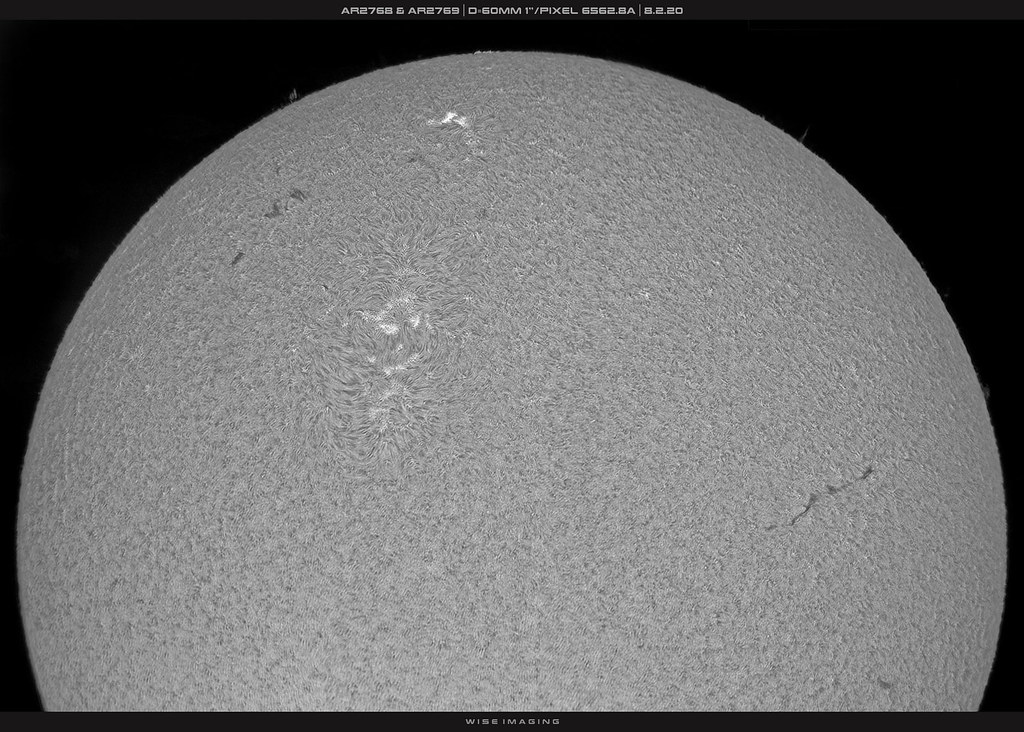




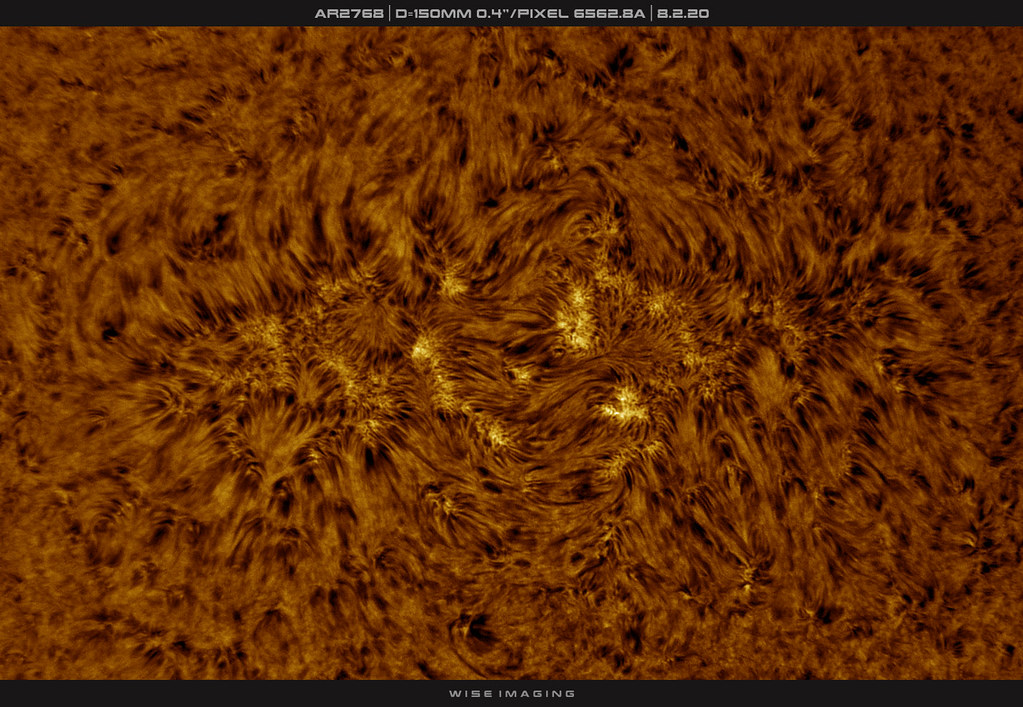




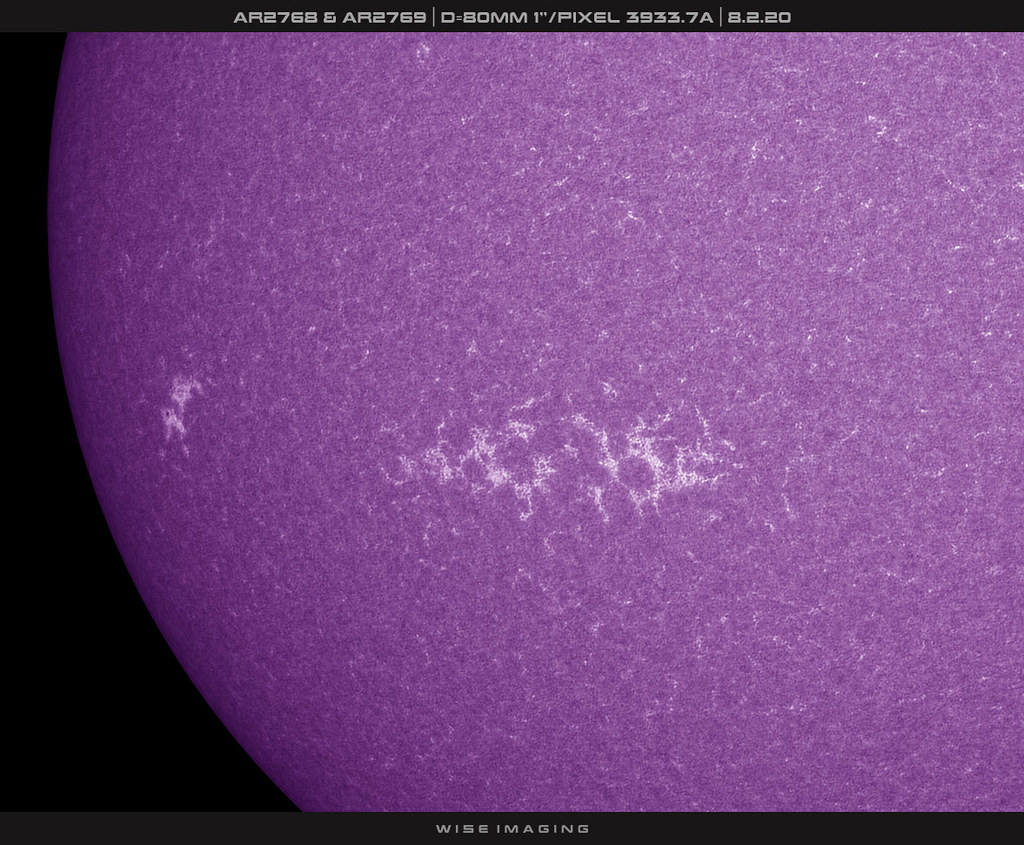















































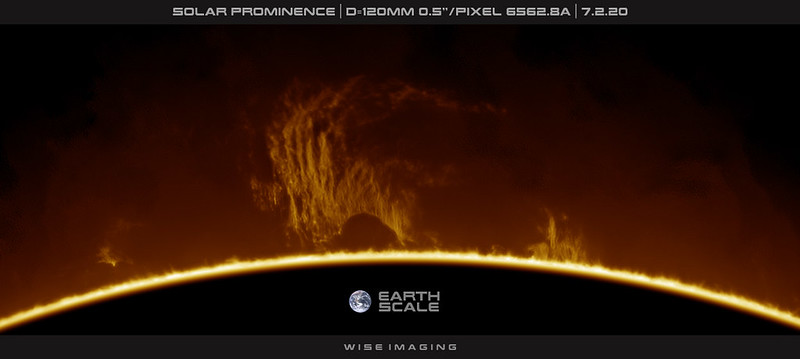

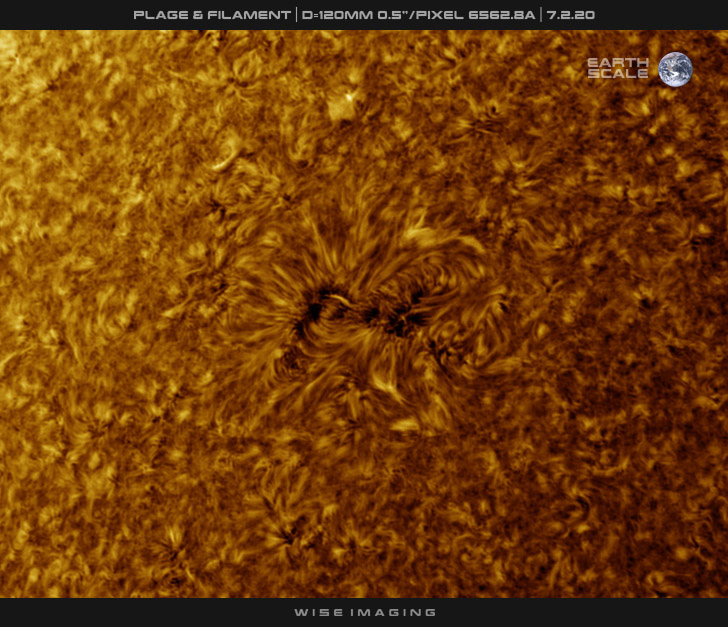
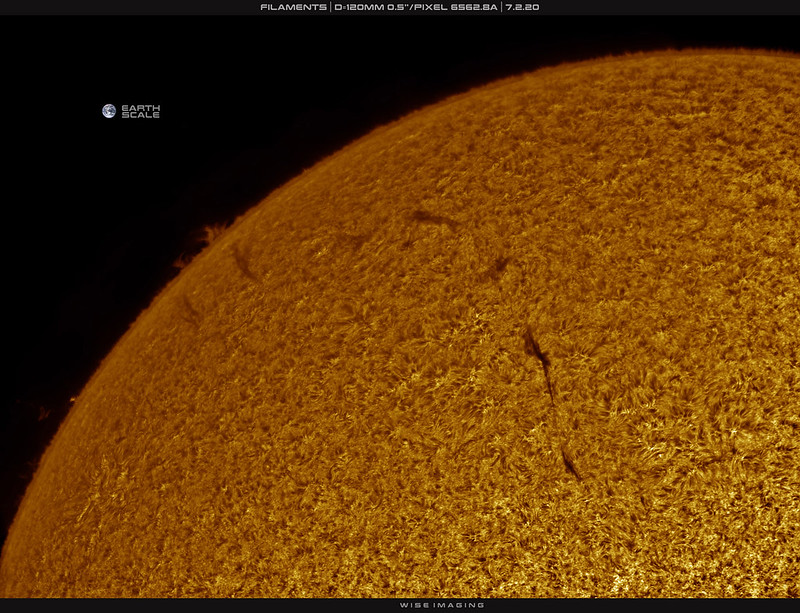


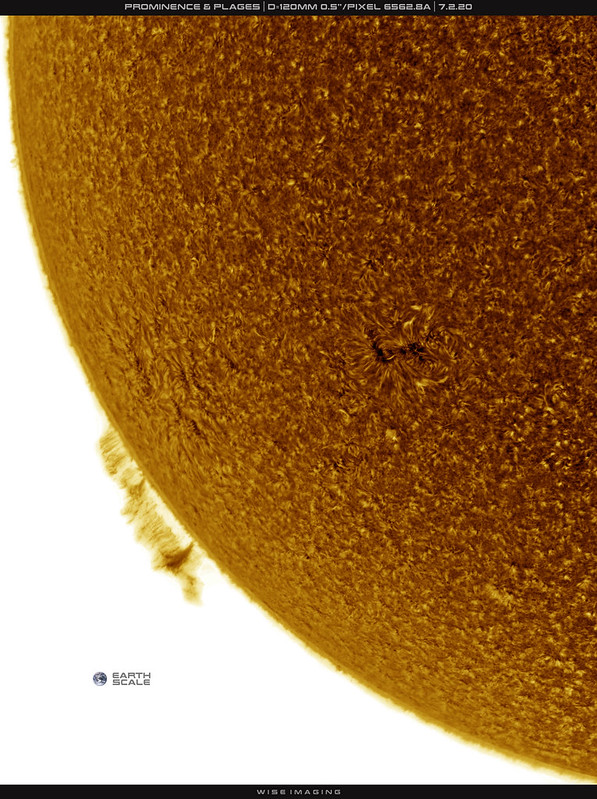

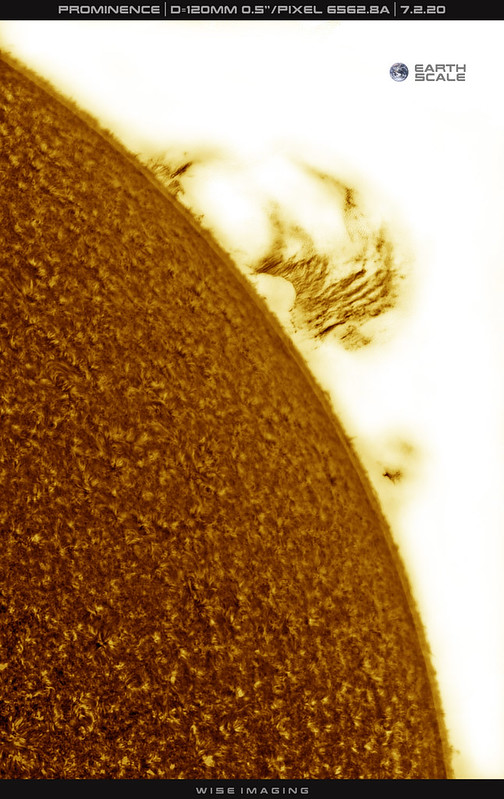





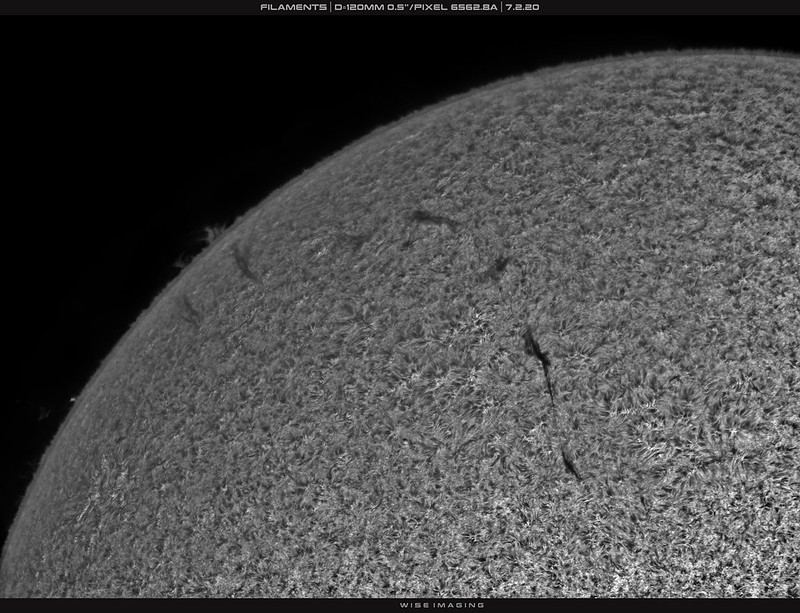
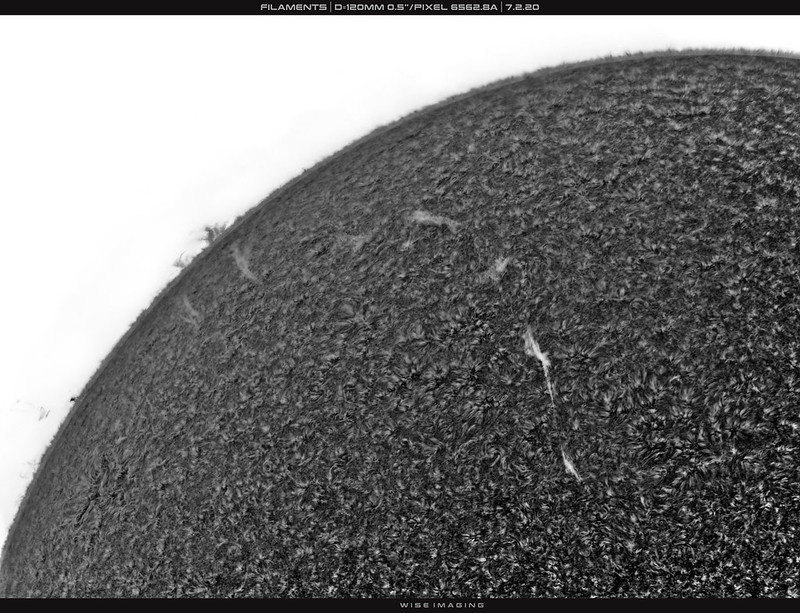

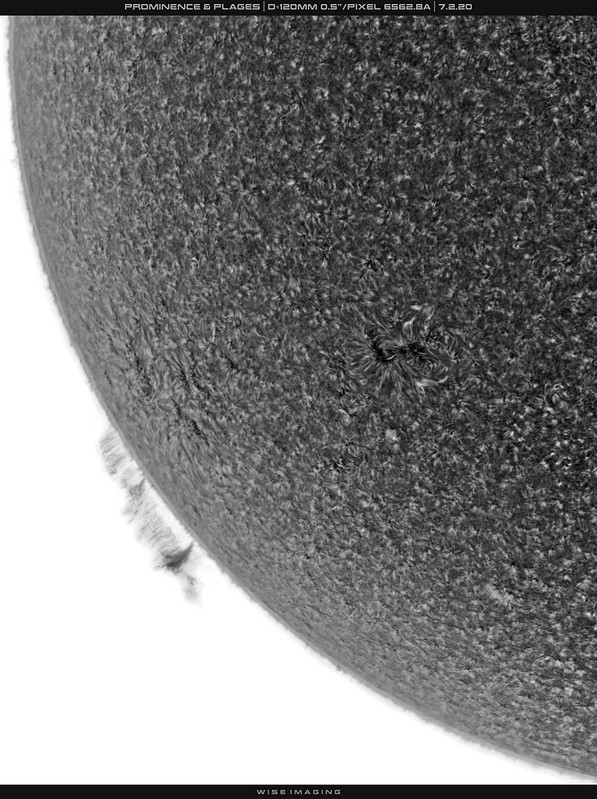






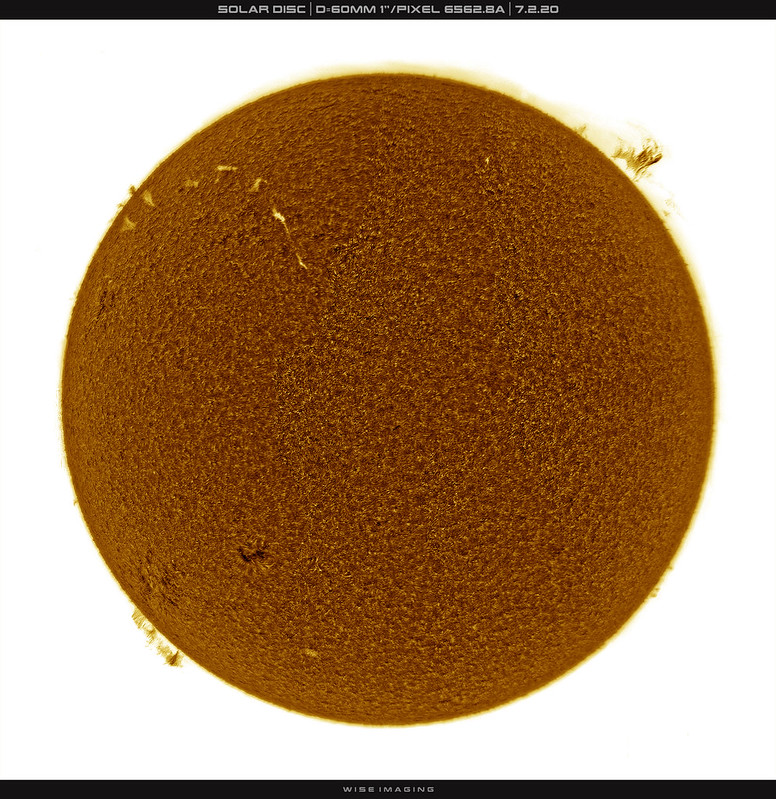
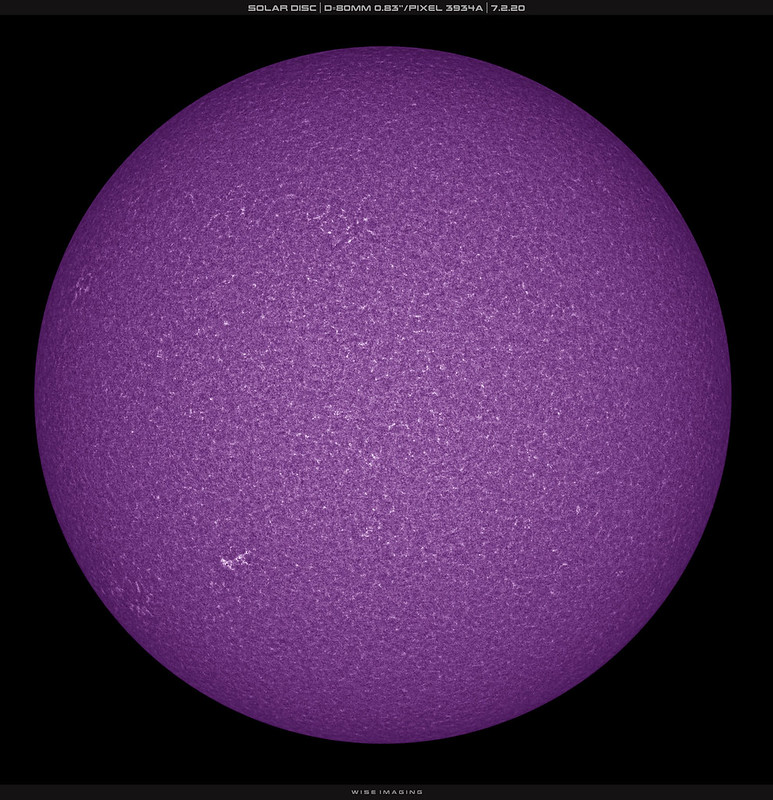




















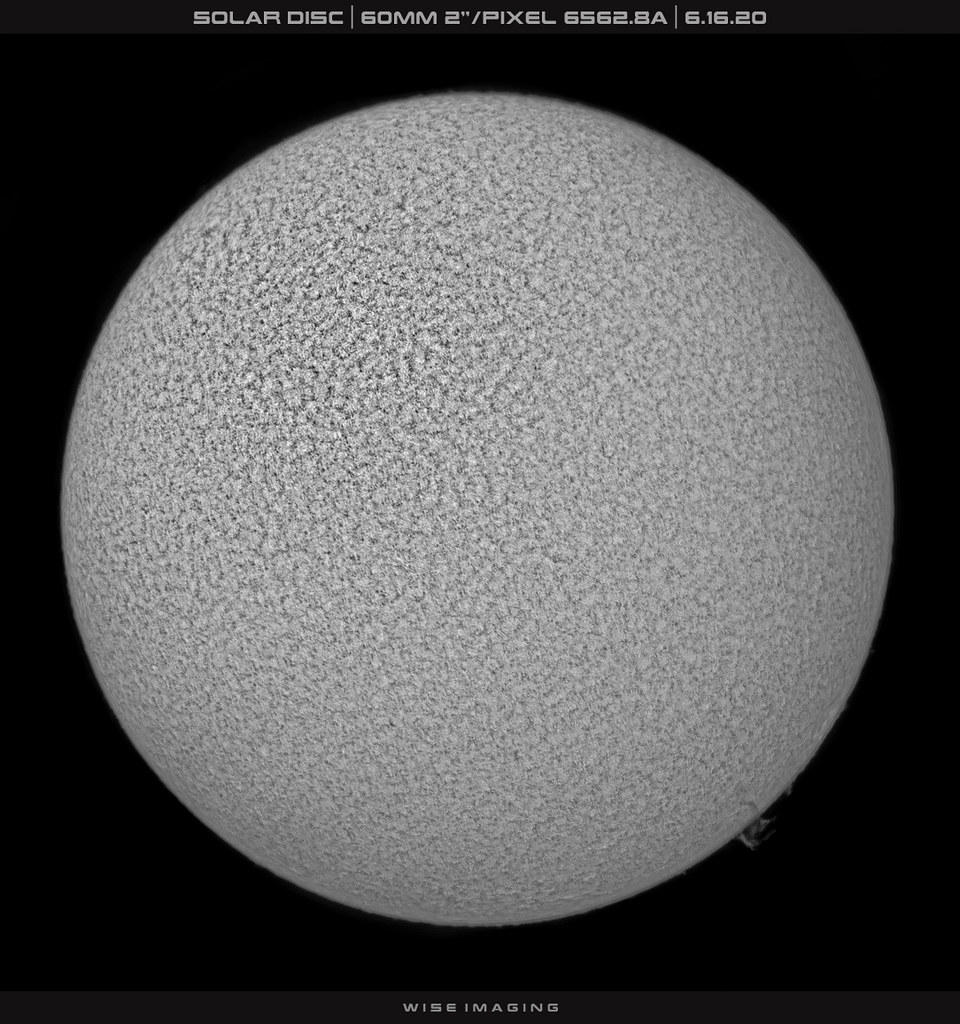







































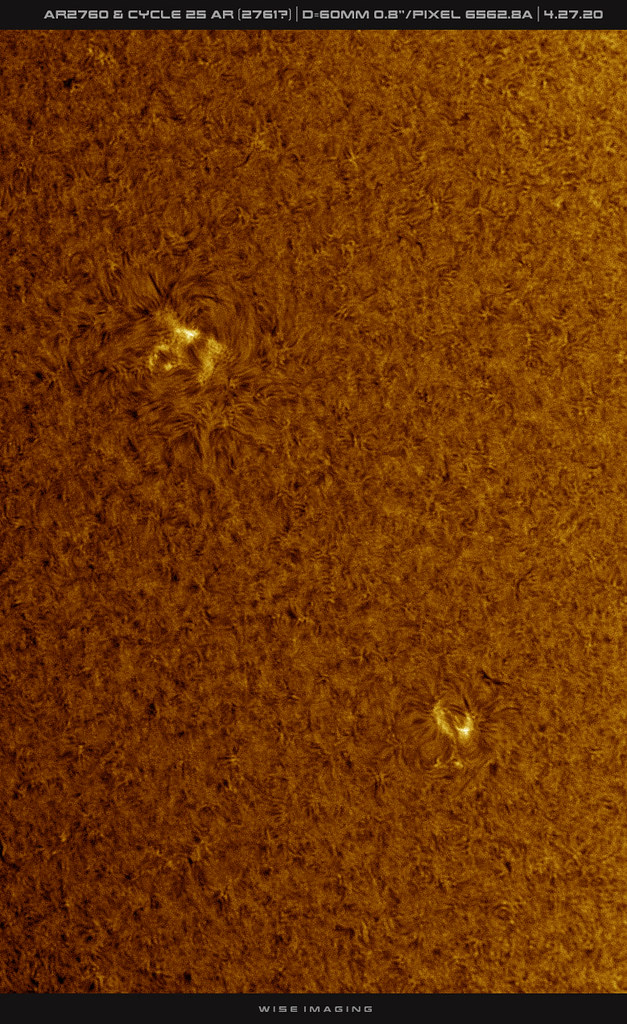
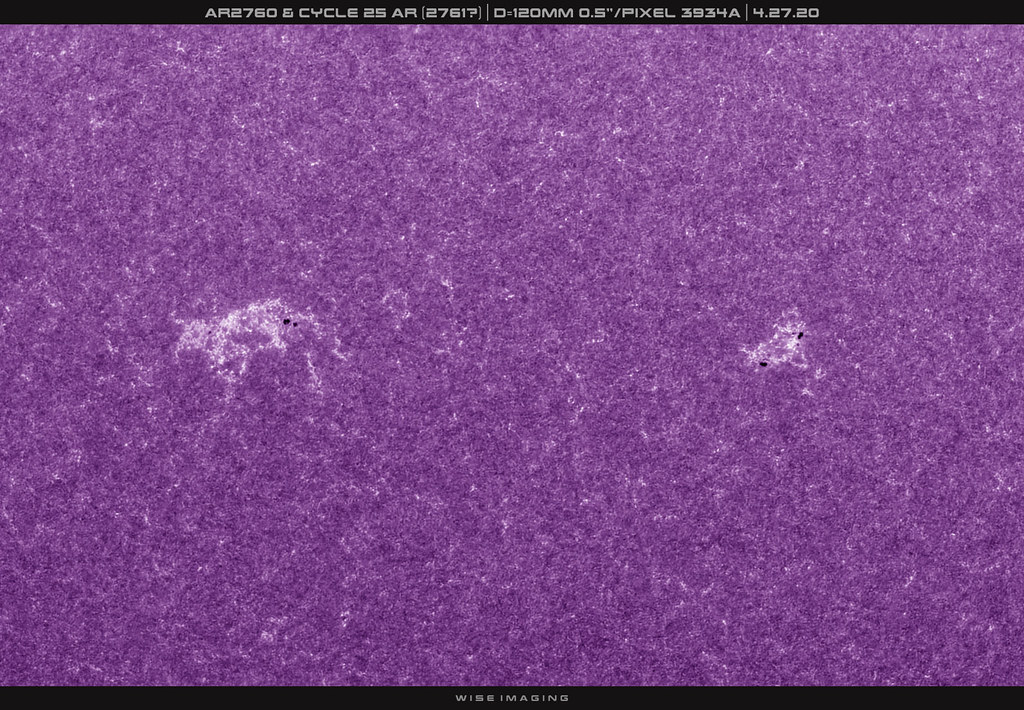
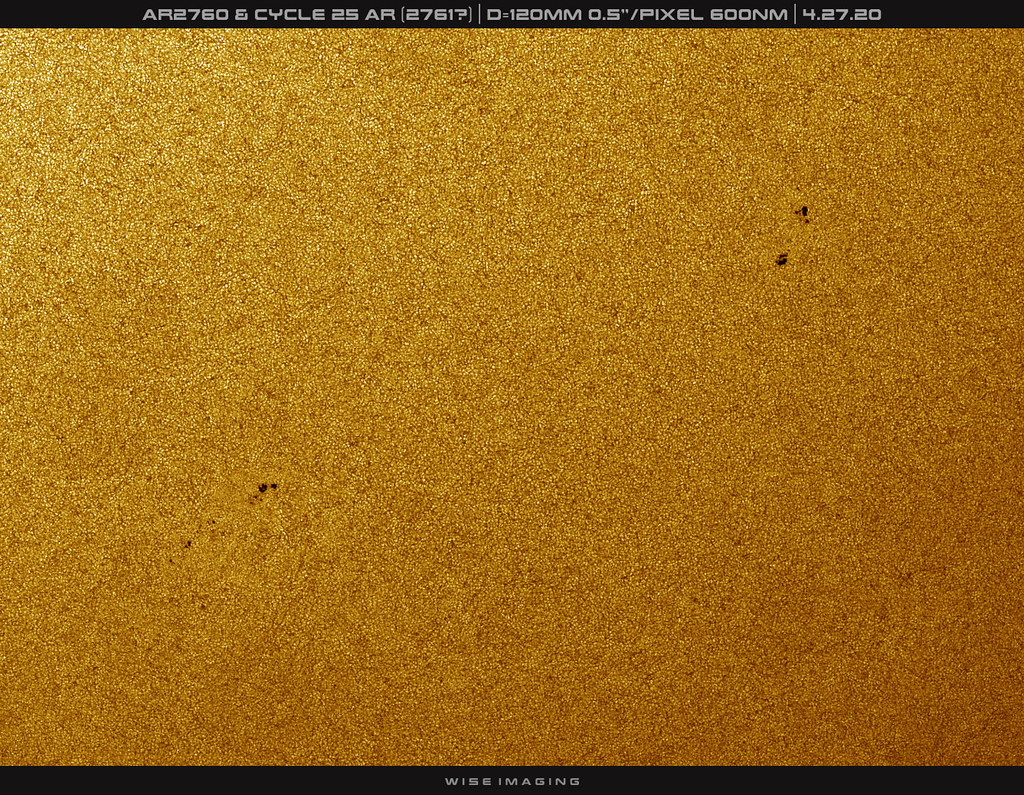





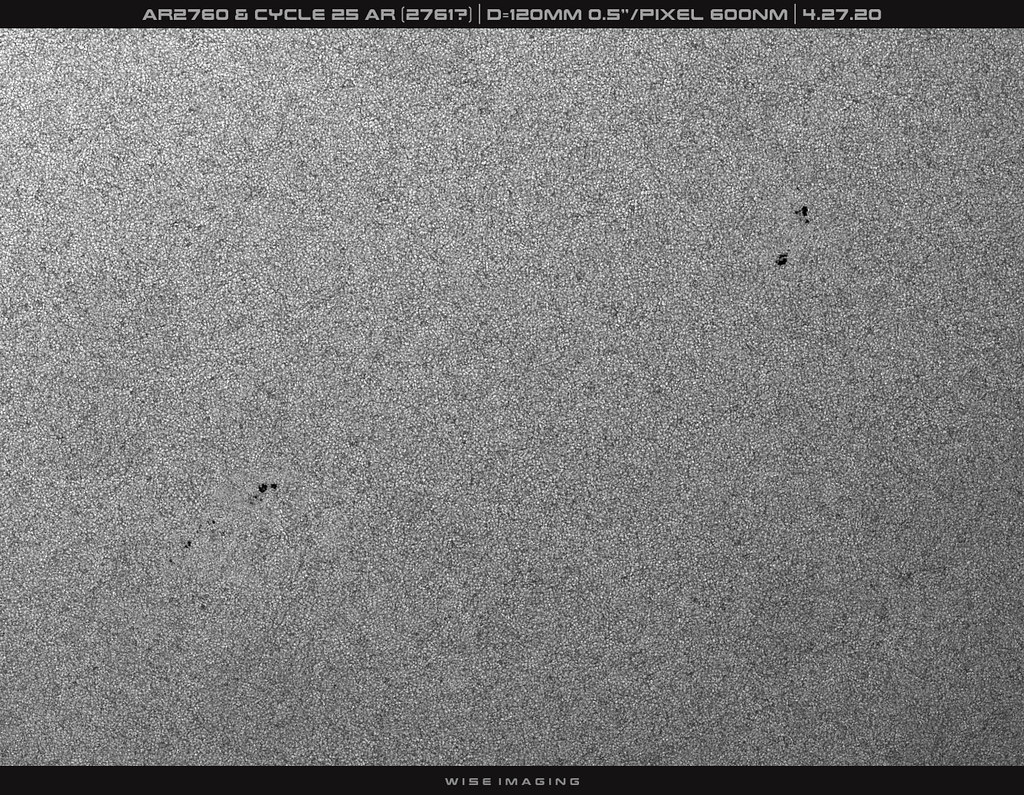
























































AR's 2768, 2769, 2770 in High Res from 200mm | HA | Aug 5th 2020
in Imaging - Solar
Posted · Edited by MalVeauX
Hey all,
With the stormy season here in Florida, sometimes I get decent seeing to attempt higher resolution and fine image scales. Today's seeing was good but not as good as the other day. I tried to extract what I could from the seeing conditions around 0.4"~0.5" arc-seconds when possible to look at our three cycle 25 AR's in high resolution at 0.3"/pixel from an 8 inch solar scope. I did some small scale images in HA & CaK of the three AR's for reference of position and the difference in resolution.
(the color image of AR2770 ended up front page of SpaceWeather today)
B&W:
Colored:
Seeing Conditions over 1 hour (very easy pattern to see it degrade over time rapidly):
Equipment:
C8 Edge HD SCT
+ Aries 214mm Tri-band D-ERF
+ Baader Red CCD-IR Block Filter (secondary D-ERF) + PST Etalon (HA) + 10mm BF + ASI290MM (HA)
+ Baader Red CCD-IR Block Filter (secondary D-ERF) + Baader 610nm + Baader ND3.0 + ASI290MM (Photosphere)
ED 80 Refractor
+ Solarmax II 60mm Etalon + PST Etalon + 10mm BF + ASI290MM (HA)
+ Lunt Cak B1200 + 2x Barlow + ASI290MM (CaK)
Very best,